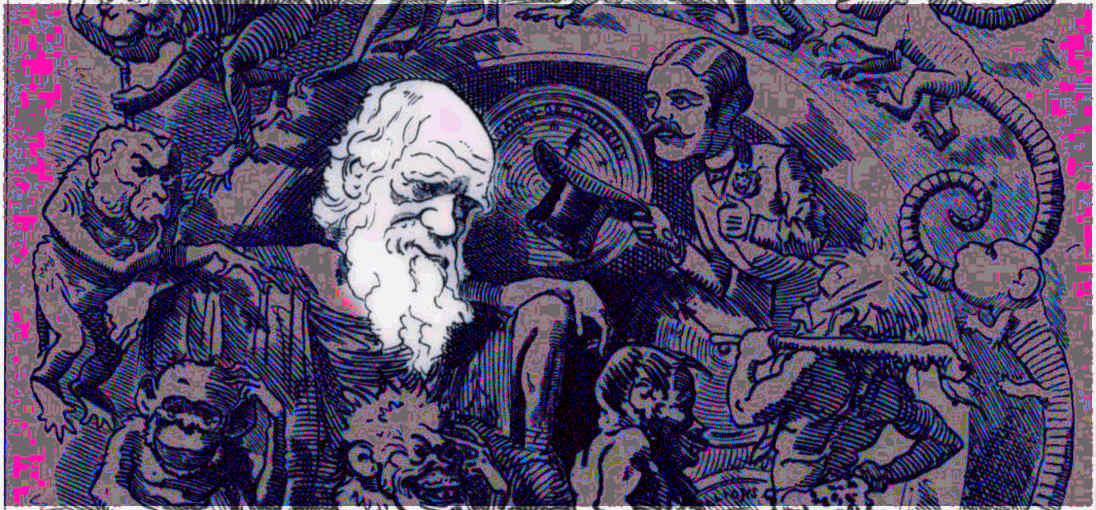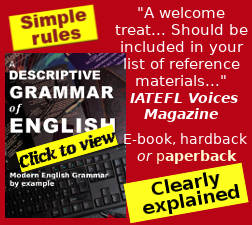
Charles Darwin
A genius remembered
Linguapress
 Darwin aged 31. He was already acclaimed as one of Britain's greatest
scientists.
Darwin aged 31. He was already acclaimed as one of Britain's greatest
scientists.Yet Darwin did not invent: he did not even propose a totally new theory* : but by years of careful observation, painstaking study, and analogical deductions, he managed to formulate in a coherent and scientific fashion, a theory which rapidly gained credence as the correct, or basically correct explanation of the diversity of life on our earth.
It was in November 1859 that Darwin published his fundamental work, The Origin of Species by means of Natural Selection.
Charles Darwin was born into a family of thinkers. His father was a Fellow of the Royal Society (the elite circle of top British scientists), his mother was the daughter of Josiah Wedgwood, the man who founded the famous Wedgwood Potteries, and his grandfather, Erasmus Darwin, was a famous physician, radical thinker and philosopher who, like his grandson, spent much time studying the evolution of life.
After a childhood in the town of Shrewsbury, where he was educated at the Grammar School, Darwin went up to Edinburgh University to study medecine and natural history. When he was eighteen, he left Edinburgh and went to Cambridge University, planning to enter the church: but he was more interested in science than in religion and in the end he abandoned theology.
Shortly after graduating from Cambridge, he got a job as a naturalist on the ship H.M.S. Beagle, which was about to start on a scientific and cartographic survey of the South American coast. The journey started in December 1831 and was to last almost five years, during which time he amassed considerable documentation.
Darwin was particularly struck by the fauna of the south seas, notably by the tortoises he found on the Galapagos Islands, a group of Pacific Islands where nature seemed different from nature in other lands. The Galapagos tortoises, Darwin observed, differed from island to island, and this, he deduced, implied different forms of evolution, since the animals obviously came from the same origins. Darwin was also struck by the iguanas he found, and observed that those which lived in water had heads suitable for finding food among stones, whilst those that lived on land had a sharper profile, more fit for a herbivorous animal.
Darwin developed his theory of evolution, but it was not until 1859 that he actually published it. It was instantly seen as a great milestone in scientific thought, and precipitated violent argument all over Europe. Many found fault in it, and Darwin spent the rest of his life modifying aspects of his theory in the light of other people's observations. He also wrote a dozen or so other books on aspects of botany and biology, including his Descent of Man (1877). The debate has continued ever since; contested for a while in the Soviet Union, because of its anti-egalitarian implications, Darwinism, or Neo Darwinism (Darwinian theory modified by Mendelian genetic theory) is now accepted by almost every scientist.
DARWIN'S THEORY – IN BRIEF
Recommended
by teachers worldwide
FREE E-grammar
for KIndle Unlimited subscribers. Otherwise e-book from Amazon from just €3.99, £3.99 or $4.99

Also available for American English as
A New English Grammar
Darwin
noted that in any species, no two examples are identical. There are
always great or small differences between specimens: he also observed,
like Malthus, that in all living species, some specimens reach
maturity, others do not ("the survival of the fittest"). From this he
concluded that life evolves along different lines in different
circumstances, according to what is fittest in each particular
situation. He called this the principle of natural
selection. He confirmed it
by personal observation of artificial
selection, the
way animal or plant breeders
produce new varieties by carefully
selecting and breeding specimens which show the desired qualities.
Neo-Darwinian theory applies principles of genetics to explain the
inequal transmission of hereditary
features from one
generation to the next. FREE E-grammar
for KIndle Unlimited subscribers. Otherwise e-book from Amazon from just €3.99, £3.99 or $4.99

Also available for American English as
A New English Grammar
WORDS
painstaking : taking great trouble - coherent : logical - gain credence: become accepted - physician : doctor (do not confuse with physicist) - were prevalent : prevailed, were greater - graduate : finish one's studies - cartographic : map-making amass : collect - fauna : animals, etc - struck : impressed - milestone : turning point, moment - fit : adapted to the circumstances, and/or healthy - breed : produce (animals, plants) - feature : characteristic.Printing: A printer-friendly document -
Copyright © Linguapress. Do not copy this document to any other website
Copying permitted for personal study, or by teachers for use with their students
STUDENTS' WORKSHEET - interactive
Darwin - a genius remembered
Text study.Word
endings :
replace the word-endings that
are missing from the following extract
Darwin, biolog, botan, and geograph, was a scient whose name is usu placed on a level with the men like Copernicus and Einstein, men whose persever and convict led them to see great new truths, to understand whole new domains of exist.
Yet Darwin did not invent: he did not even propose a total new theory* : but by years of care observ, painstak study, and analog deduct, he manag to formul in a coher and scient fash, a theory which rapid gained cred as the correct, or basic correct explan of the divers of life on our earth.
Darwin, biolog, botan, and geograph, was a scient whose name is usu placed on a level with the men like Copernicus and Einstein, men whose persever and convict led them to see great new truths, to understand whole new domains of exist.
Yet Darwin did not invent: he did not even propose a total new theory* : but by years of care observ, painstak study, and analog deduct, he manag to formul in a coher and scient fash, a theory which rapid gained cred as the correct, or basic correct explan of the divers of life on our earth.
Questions
and answers:
Using the prompts given, imagine six questions that you might have liked to ask Darwin if you'd been around in 1860, and imagine his answers using information from this article or other sources. For the questions, keep your language simple. The answers can be as long as you like, and the answer boxes will expand to take as much text as you enter.
Using the prompts given, imagine six questions that you might have liked to ask Darwin if you'd been around in 1860, and imagine his answers using information from this article or other sources. For the questions, keep your language simple. The answers can be as long as you like, and the answer boxes will expand to take as much text as you enter.
You
: 1. What
Darwin:
You
: 2. Where
Darwin:
You
: 3. How
Darwin:
You
: 4. Why
Darwin:
You
: 5. Do
Darwin:
You
: 6. Have
Darwin:
Teachers:
Listening
and remembering.
This is a concluding exercise designed to check that students have both
understood and remembered the text, after going through it in class or
on their own. Play the following extract to your class, stopping the
audio at each ♦ , and
asking students to remember how the sentence continued.
If you think there are too many ♦ markers, break the audio only before words or expressions highlighted in yellow, which concern structures and grammar, rather than information or vocabulary. Sometimes you may need to help students by providing the next word.
If you think there are too many ♦ markers, break the audio only before words or expressions highlighted in yellow, which concern structures and grammar, rather than information or vocabulary. Sometimes you may need to help students by providing the next word.
Shortly
after graduating from
Cambridge, he got a job ♦ as
a naturalist on the ship H.M.S. Beagle, which
was ♦ about to start
on a scientific and cartographic
survey of the ♦ South
American coast. The journey started in December 1831 and ♦ was to last almost
five years, during ♦ which
time he amassed
considerable documentation.
Darwin was particularly struck by ♦ the fauna of the south seas, notably by the tortoises he found ♦ on the Galapagos Islands, a group of Pacific Islands ♦ where nature seemed different from nature in other lands. The Galapagos tortoises, Darwin observed, differed♦ from island to island, and this, he deduced, implied♦ different forms of evolution, since the animals obviously came ♦ from the same origins. Darwin was also struck by the iguanas he found, and observed that ♦ those which lived in water had heads suitable ♦ for finding food among stones, whilst ♦ those that lived on land had a sharper profile, more ♦ fit for a herbivorous animal.
Darwin developed his theory of evolution, but it was ♦ not until 1859 that he actually published it. It was instantly seen as a ♦ great milestone in scientific thought, and precipitated ♦ violent argument all over Europe. Many ♦ found fault in it, and Darwin spent the rest of his life ♦ modifying aspects of his theory ♦ in the light of other people's observations.
Darwin was particularly struck by ♦ the fauna of the south seas, notably by the tortoises he found ♦ on the Galapagos Islands, a group of Pacific Islands ♦ where nature seemed different from nature in other lands. The Galapagos tortoises, Darwin observed, differed♦ from island to island, and this, he deduced, implied♦ different forms of evolution, since the animals obviously came ♦ from the same origins. Darwin was also struck by the iguanas he found, and observed that ♦ those which lived in water had heads suitable ♦ for finding food among stones, whilst ♦ those that lived on land had a sharper profile, more ♦ fit for a herbivorous animal.
Darwin developed his theory of evolution, but it was ♦ not until 1859 that he actually published it. It was instantly seen as a ♦ great milestone in scientific thought, and precipitated ♦ violent argument all over Europe. Many ♦ found fault in it, and Darwin spent the rest of his life ♦ modifying aspects of his theory ♦ in the light of other people's observations.
Technical English
Though this is a semi-technical text rather than a technical text, it employs many of the lexical features of technical English. The blank-fill exercise on endings highlights the use of derived words. In the section on Darwin's Theory - in brief, note the use of quantifiers and articles, and in particular the absence of articles before generalisations, principles and processes.
Other language points
Some other points that teachers might like to explain to students.
- First paragraph: the illustrious . Adjectives are not normally used as nouns in English: most adjectives cannot be used in this way. But some adjectives, notably some that describe general human conditions, can do so; the rich, the poor, the lonely, the great etc.
- men whose.... the word men is repeated at the start of the relative clause, to stress that whose refers to all the men concerned, not just to its direct antecedent Einstein.
- Seventh paragraph: those which .... those that .... These two alternative expressions are quite interchangeable
- Last paragraph: Malthus. Thomas Malthus, the father of demographics or population studies. Malthus argued that populations could not continually expand in size, as their growth would be limited by the availability of natural resources : "the increase of population is necessarily limited by the means of subsistence". Malthus failed to foresee that improved means of production and increased or better use of resources would allow populations to grow massively from pre-Industrial Revolution levels to today's levels; but in the end he was right. Populations cannot continue growing for ever.... a problem that is facing the world in the 21st century.
- according to what is fittest. Note the use of the nominal relative pronoun what, which means that which. The pronoun includes its own antecedent.
- inequal, (or unequal) : both forms are found, though unequal is more common in everyday English. The use of inequal stresses a semantic link to the noun inequality.
Darwin is one of the small number of people whose names have been made into new words in languages all over the world. Darwinism and darwinian are well-known English words that have been copied into many other languages. French darwinien, German darwinistisch, Arabic دارويني , Russian дарвинов�?кий, Japanese ダーウィニアン and many more languages.
Interestingly Thomas Malthus, mentioned in the article has given his name to the word malthusian, which has been copied into new words in many languages too.
More grammar : For a clear presentation of English Grammar, discover A Descriptive Grammar of English, published by Linguapress, and available as an ebook, hardcover or paperback from Amazon worldwide, from Barnes & Noble in the USA or Waterstones in the UK, plus other good bookshops..
© linguapress.com



